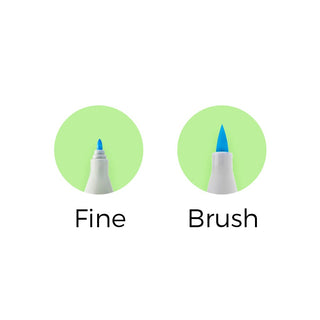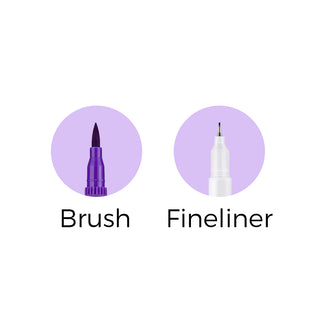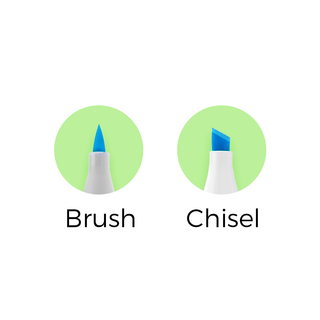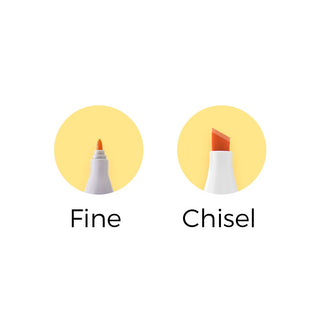Ink, as one of the indispensable tools for art creation, has a unique formula and composition that directly affects the color, adhesion and durability of the drawing. The process of making alcohol-based drawing markers includes three main ingredients: color, resin, and alcohol, each of which plays a unique role in co-constructing the artwork.
1 Alcohol-based Drawing Marker Primary Agent
1.1 Pigments/Dyes
This is one of the main components of the ink and determines the color of the ink. Pigments can be organic or inorganic, depending on the application of the ink and the desired color.
Typically, most of the colorants used in alcohol markers for drawing are organic. Organic colorants contain carbon in their chemical structure, they typically exhibit bright, vibrant colors, and are popular for art and painting applications. These organic colorants have good solubility, which allows them to mix evenly in an alcohol solution to form a liquid ink suitable for markers. In addition to this, organic colorants have high color saturation and a range of color variations, making them capable of providing a wide range of color options that artists need. These colorants can create markers in a wide range of different colors, from basic reds, blues, and greens to more complex shades, all of which can be achieved by different organic colorants.
1.2 Resin
Resin is the other main ingredient used to provide ink adhesion, tack and shine. In alcohol-based drawing markers, the role of resin is to provide adhesion, tack and stability to the coating. Resin helps the ink adhere to the drawing surface, ensuring a smooth line while ensuring color stability and longevity. Below are some of the common raw materials for resins used in alcohol-based paint markers:
1.2.1 Polyamide Resin
This is a common type of resin with excellent adhesion and abrasion resistance. It is often used to make more durable markers for a variety of surfaces, including paper, fabric and plastic.
1.2.2 Phenolic Resin
Phenolic resin is used in inks to enhance adhesion and improve durability. It is often used in the manufacture of markers that require good performance on a variety of surfaces.
1.2.3 Alkyd Resin
This is a synthetic resin that is often used to provide fluidity and fast drying properties to the ink. It helps to ensure smooth lines during the drawing process and dries quickly after coating, preventing the coating from blurring or smudging.
1.2.4 Epoxy Resin
In some cases, epoxy resins may be used to increase the water and chemical resistance of an ink. This may be an important characteristic for paintings that need to be used in wet or specialized environments.
1.3 Alcohol
1.3.1 Alcohol's Major Role in Ink
Alcohol is the main ingredient commonly used as a volatile organic solvent that helps inks dry quickly. It also adjusts the viscosity and flow of the ink. In alcoholic drawing markers, the role of alcohol is primarily as a volatile organic solvent.
Its main roles include the following:
1.3.1.1 Rapid Drying
Alcohol is a fast evaporating solvent that helps the ink to dry quickly after drawing. This is an important property in drawing markers as it allows the artist to avoid the coating from smudging while drawing patterns or doodling.
1.3.1.2 THINNING INK
Alcohol can be used to adjust the consistency and viscosity of ink. By adding just the right amount of alcohol, the fluidity of the ink can be altered to make it glide more easily across the drawing surface while maintaining good coating properties.
1.3.1.3 Provides Fluidity
Alcohol helps the ink to flow more smoothly in the nib, ensuring a smooth line during the drawing process.
1.3.2 Key Traits of Alcohol in Art Markers
For alcohol-based drawing markers, the alcohol component usually needs to have the following characteristics:
1.3.2.1 High Purity
In order to ensure the quality and stability of the ink, the alcohol usually needs to have a high purity to avoid impurities affecting the pigment and other ingredients.
1.3.2.2 Low Odor
Artists often want to avoid strong odors when using markers, so specially formulated alcohol components may be treated to reduce their odor.
1.3.2.3 Compatibility with Pigments
Alcohol must be compatible with the chosen organic pigments to ensure consistent color and performance of the ink.
1.3.2.4 Rapid Evaporation
In order to achieve a fast drying effect, the alcohol needs to be an organic solvent that evaporates quickly.
1.2 Alcoholic Drawing Marker Additive
While exploring ink formulations, it is equally vital to understand the role of excipients. In addition to the main ingredients, excipients play a key role in alcohol-based drawing markers.
1.2.1 Additives
Additives are used to improve the performance of the ink and play a variety of roles in alcohol-based drawing markers, where they are used to improve the performance and stability of the ink. Below are some of the common additives that may be found in alcohol-based marker pens and their functions:
1.2.1.1 Dispersants
Dispersants are used to ensure that the pigments are evenly dispersed in the ink and to prevent them from settling. This helps maintain color uniformity and prevents clumping or pigment aggregation in the ink.
1.2.1.2 Antioxidants
Antioxidants are added to the ink to prevent oxidation of the pigments during prolonged storage or use. This helps maintain color stability and durability.
2.1.3 Antimicrobial Agents
Antimicrobial agents may be added to alcohol-based drawing markers to prevent the growth of bacteria or microorganisms in the ink.
2.1.4 Fade Resistors
Some additives may be used to improve the lightfastness of the ink, preventing the color from fading under sunlight or ultraviolet light.
2.1.5 Rheology Modifiers
Rheology modifiers help to regulate the flow of the ink so that it flows more easily on the drawing surface while maintaining sufficient viscosity at the nib.
2.1.6 pH Modifiers
pH modifiers can be used to adjust the acidity or alkalinity of an ink to ensure compatibility with paper or other drawing surfaces.
2.1.7 Wetting Agents
Wetting agents improve the wetting of ink on the drawing surface, ensuring that it spreads evenly and adheres to the surface.
2.1.8 Wax Resist
Where use with wax or coated surfaces is required, wax resist may be added to ensure reliable ink adhesion.
In the production of alcohol-based drawing markers, the precise proportioning and application of these auxiliary ingredients play a vital role in the quality of the ink and the performance of the final artwork. They complement the main ingredient and work together to build a sharpie with vibrant colors and smooth lines. In the process of creation, these seemingly small auxiliary materials carry the stability and expressive power of the ink, bringing broader creative space and possibilities for the artist.


























